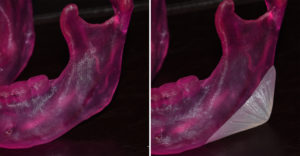The contemporary desire for a well defined jaw angle rivals that of the more well established demand for increased chin projection. Even though it is on the back part of the jaw, its influence on the perception of the lower face is significant as there are two jaw angles that project out from the side of the face. Between the chin and the jaw angles, these three lower jaw bony projections influence how well defined the lower face is.
While most people understandably perceive that a prominent jaw angle means one this is wide, this is not absolutely so. A prominent jaw angle, particularly in females, may be one that has a good definition and is clearly seen. It does not need to be excessively wide or unduly vertically long. It may just need to have a good and visible shape.

Such a small vertical jaw angle cap implant is most commonly used in females to create an angular appearance but without adding an appreciable size increase. Like all jaw angle implants it is placed from incisions inside the mouth and is best secured with a small microscrew to ensure the stability of its placed position on the bone. Positioning over the jaw angle point requires release of the tendons that adhere to the bony jaw angle point.
Dr. Barry Eppley
Indianapolis, Indiana


